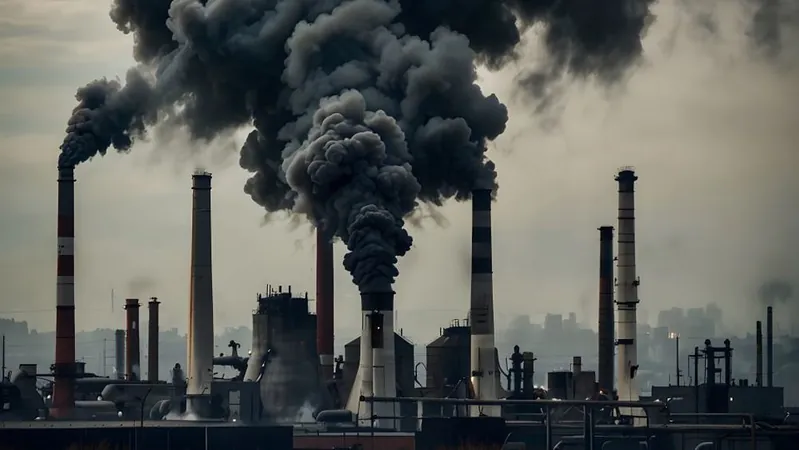
Revolutionary MOF Technology Captures CO2 from Industrial Emissions at Unprecedented Temperatures!
2024-11-18
Author: Rajesh
Introduction
A groundbreaking development in carbon capture technology has emerged as researchers unveil a new class of Metal-Organic Frameworks (MOFs) capable of capturing hot carbon dioxide (CO2) directly from industrial exhaust streams. This innovative method, detailed in a recent publication in *Science*, promises to transform the future of carbon capture, making it more efficient and cost-effective.
Traditional Carbon Capture Technologies
Traditionally, carbon capture systems utilize liquid amines that work optimally between 40°C and 60°C (100°F to 140°F). However, many industries, such as cement manufacturing and steel production, face a substantial challenge. Their emissions can exceed 200°C (400°F) and sometimes even reach heights of 500°C (930°F). Current technologies require expensive cooling systems to lower these exhaust temperatures before they can effectively capture CO2.
A New Dawn for Carbon Capture
According to UC Berkeley postdoctoral fellow Kurtis Carsch, "Our discovery is poised to change how scientists think about carbon capture. We've found that a MOF can capture carbon dioxide at unprecedentedly high temperatures - temperatures that are relevant for many CO2 emitting processes." This insight opens the door for potential applications in a variety of high-temperature industrial processes that were previously considered infeasible.
The MOF's Unique Structure
The MOF evaluated by researchers features a complex crystalline structure composed of metal ions and organic linkers, presenting an extensive internal surface area—equivalent to six American football fields packed into a single tablespoon. Carsch noted the heightened density of sites in these frameworks that facilitate the efficient capture and release of CO2, making them superior to older models.
Significant Experimental Findings
In controlled experiments simulating industrial environments, this new MOF demonstrated the ability to effectively capture CO2 from emissions produced during cement and steel manufacturing, which typically contain 20% to 30% CO2. Additionally, the material showcased its utility for capturing CO2 from natural gas power plants, where emissions contain roughly 4% CO2.
Research Background
Carsch, alongside co-first author Rachel Rohde, conducted research in the laboratory of renowned chemist Jeffrey Long. Recognizing previous attempts to improve CO2 capture technologies, Long’s team previously developed an amine-based MOF in 2015. The new-generation MOFs under study now combine the attributes of traditional amine adsorbents with enhanced capabilities offered by zinc hydride sites, significantly improving their effectiveness at elevated temperatures.
Stable and Efficient Carbon Sequestration
"This material is highly stable and enables deep carbon capture, meaning it can sequester 90% or more of the CO2 it encounters," stated Rohde. The material exhibits CO2-binding capacities that compete directly with amine-linked MOFs but function efficiently at higher temperatures.
Mechanism of Action
The mechanism behind this capture technology is equally remarkable. Once the MOF is saturated with CO2, the gas can be released by decreasing the partial pressure of CO2, either through gas flushing or vacuum application, thereby preparing the MOF for reuse in another cycle.
Significance of the Discovery
Long highlighted the paradigm shift signified by this research, noting, "It was generally thought impossible to capture CO2 with a porous solid at temperatures above 200°C. This work shows that with the right functionality—namely, zinc hydride sites—rapid, reversible, high-capacity capture of CO2 can indeed be achieved at temperatures like 300°C."
Future Research Directions
Looking to the future, Rohde, Long, and their fellow researchers are exploring adaptations of this metal hydride MOF to enhance its ability to adsorb a broader spectrum of gases, potentially paving the way for innovative solutions in combating global CO2 emissions.
Conclusion
As industries worldwide struggle to meet stringent environmental regulations, this technological advancement may signal a major turning point in the fight against climate change, providing a sustainable method for mitigating carbon emissions from some of the most polluting sectors. Stay tuned as this revolutionary technology reduces carbon footprints and reshapes industrial practices!




 Brasil (PT)
Brasil (PT)
 Canada (EN)
Canada (EN)
 Chile (ES)
Chile (ES)
 España (ES)
España (ES)
 France (FR)
France (FR)
 Hong Kong (EN)
Hong Kong (EN)
 Italia (IT)
Italia (IT)
 日本 (JA)
日本 (JA)
 Magyarország (HU)
Magyarország (HU)
 Norge (NO)
Norge (NO)
 Polska (PL)
Polska (PL)
 Schweiz (DE)
Schweiz (DE)
 Singapore (EN)
Singapore (EN)
 Sverige (SV)
Sverige (SV)
 Suomi (FI)
Suomi (FI)
 Türkiye (TR)
Türkiye (TR)